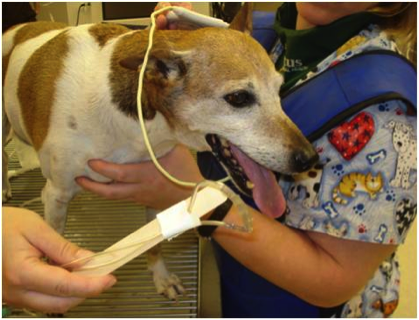Dr. Tim Crowe, DVM, DACVS, DACVECC
Dr. Tim Crowe, DVM, DACVS, DACVECC, is a board-certified veterinary surgeon, educator, and inventor. He is one of the founders of the American College of Veterinary Emergency and Critical Care. Dr. Crowe routinely lectures and teaches on a number of innovative therapies. He adopted the Assisi Portable, which he dubbed the "loop", several years ago after evaluating it and finding astonishing results. In part 1 of this interview (featured fully in our newsletter--sign up), Dr. Crowe details some of his cases using the Assisi loop and the incredible outcomes he has achieved with canines.
Emergency intervention: respiratory
A little, middle-aged, neutered female terrier mix was brought in with difficulty breathing. She had been diagnosed with tracheal bronchitis a few days prior to this emergency presentation and then was brought to us for acute difficulty breathing. She was breathing very sonorously and was also very cyanotic. She was what we call a “landshark”–just doesn’t like people and will bite easily. So we had the challenge of trying to examine and treat the dog without getting chomped. We started out by giving her hi-flow low-bi oxygen and that’s about all we thought we could do. But then we decided to try the Assisi loop. We managed to get it over her head with a “ring toss”, and within ten minutes her sonorous breathing had quieted. We saw her go from a panicked state–with extreme discomfort from not being able to breathe–to a distress score of nearly zero within 15 minutes of using the Assisi Loop. From there she was transferred to the University of Georgia for rapid intervention. But when they got in there they only noticed some collapsing trachea–the edema that had been noted prior was all gone probably due to the Assisi Loop.
Pain reduction in pre- and post-surgical treatment
Chloe is a Dachshund, seven years old, female. Her thoracolumbar pain was severe; she had essentially no deep pain sensation.
She had hemilaminectomy after which she improved. Then she got worse again. She was crying and in severe pain that referred to her neck – So now she has a neck problem. This is when she received her first Assisi loop session. Her thoracolumbar surgery was done at the University of Georgia and then she was brought to us for her neck pain. We used the Assisi Loop on the surgery site and continued to use it on her neck. The owner was the first to be really convinced–because he saw the dog all the time. He saw that the loop helped Chloe significantly with her pain. So that’s a patient who underwent cervical disk surgery and had the Assisi loop prior to surgery and post.
Accelerated post-surgical recovery
The Assisi Loop can be used after any kind of surgery, whether a radical surgery, such as the removal of a large tumor or a small procedure. We use the Assisi loop in order to speed up healing, as well as to reduce pain and swelling.
For example, we saw a large, middle-aged dog, a yellow lab with a tumor on the left chest about the size of his head. It weighed probably around 6-7 pounds growing in this dog’s chest wall. And because the dog was older, around thirteen, his owner thought that he would soon pass on and didn’t believe he should have to go through any major surgery. But when she learned that he didn’t require much surgery to remove the tumor, she went forward with it. We applied the Assisi loop immediately after the procedure for two reasons: one to help her recovery, and two to decrease pain and edema. Her owner noticed immediately that the dog appeared to be much more comfortable. The owner is a psychiatrist, so she’s very analytical and observant and was watching us closely the whole time. Now the owner is prescribing the technology with her own patients and is having some fascinating results on various neurological and mental disorders.
More case studies to come next week…

